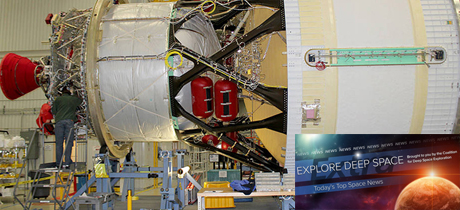In Today’s Deep Space Extra… The upper stage for the first flight of NASA’s Space Launch System heavy lift rocket has transitioned from United Launch Alliance facilities at Cape Canaveral Air Force Station, Florida, to NASA’s nearby Kennedy Space Center and the Space Station Processing Facility.
Human Space Exploration
First segment for NASA’s Space Launch System arrives in Florida
Gasworld (8/3): The upper stage for the first flight of NASA’s Space Launch System heavy lift rocket — the Interim Cyrogenic Propulsion Stage (ICPS) — has transitioned from United Launch Alliance facilities at Cape Canaveral Air Force Station, Florida, to NASA’s nearby Kennedy Space Center and the Space Station Processing Facility. The ICPS will help to power an Orion crew capsule around the moon on the first SLS flight, which is undergoing a schedule review.
The uncertain future of solar electric propulsion
Space News (8/3 on line; 7/3 in print): Solar Electric Propulsion (SEP), which was to be a featured technology in NASA’s now cancelled Asteroid Redirect Mission, is likely to remain an important part of future human exploration plans. SEP could find a home aboard NASA’s Deep Space Gateway (DSG), a lunar orbiting habitat for astronauts, and the Deep Space Transport (DST), a deep space human vehicle. Neither DSG nor DST is funded as part of NASA’s proposed 2018 budget, however.
Space Science
Op-ed | Sleepwalking away from Mars
Space News (8/3 online; 7/31 in print): Congress must move quickly to ensure NASA has the proper assets at Mars to further its robotic exploration plans, writes Casey Dreier, director of space policy for the Planetary Society. Among the needs are replacements for the aging Mars Reconnaissance Orbiter and Mars Odyssey, which function as Mars orbiting communications relays for surface rovers and landers. High resolution imager from MRO is also vital to landing site selection for future missions. Currently, NASA Mars 2020 rover is to gather samples of red planet rocks for eventual return to Earth. However, there is no firm plan to recover the samples nor timely efforts to develop a lander/assent vehicle to start them on their way to Earth, writes Dreier in an op-ed.
“People love exploration”: what New Horizons researchers learned from the Pluto flyby
Cosmos Magazine (8/4): Top scientists for NASA’s New Horizons mission, which carried out the first flyby of Pluto in 2015, visited Australia, host to a mission critical receiving antenna, last week to discuss the project. The New Horizons imagery revealed that Pluto is a surprisingly active planetary body with ice volcanoes and a large glacier. In addition to the discoveries, principal investigator Alan Stern was delighted at the interest shown by an eager public. “We made more than just scientific discoveries,” Stern said. “We rediscovered how much people love exploration.” New Horizons is on its way to a second destination.
Spaceweather.com (8/3): A solar wind stream emerging from a canyon like crevice in the sun’s outer atmosphere is likely to produce geomagnetic storms at the Earth’s poles on Friday.
Ancient asteroid family dates back to our Solar System’s early days
Space.com (8/3): Studies of the inner most region of the main asteroid belt between Mars and Jupiter have revealed a new family of asteroids. This French led research effort has identified more than 100 of the large space rocks, which average more than seven miles in diameter and possibly about four billion years old.
Other News
Op-ed | America’s future in space is both commercial and traditional
Space News (8/3 on line; 7/31 in print): Until recently a part of the Trump Administration NASA transition team, University of Southern California professor Greg Autry assesses the strengths and weaknesses of the new space and traditional aerospace sectors. Autry finds both essential to advances in science, technology, national security and the economy. And each must learn from the other, Autry writes.
Private spaceflight startup Vector pulls off second test of its micro-rocket
The Verge (8/3): Tucson based Vector logged a successful suborbital test launch of its new Vector-R launch vehicle for small satellites. Thursday’s launch was also the first for Spaceport Camden of southeast Georgia, a former NASA solid rocket motor test facility.

